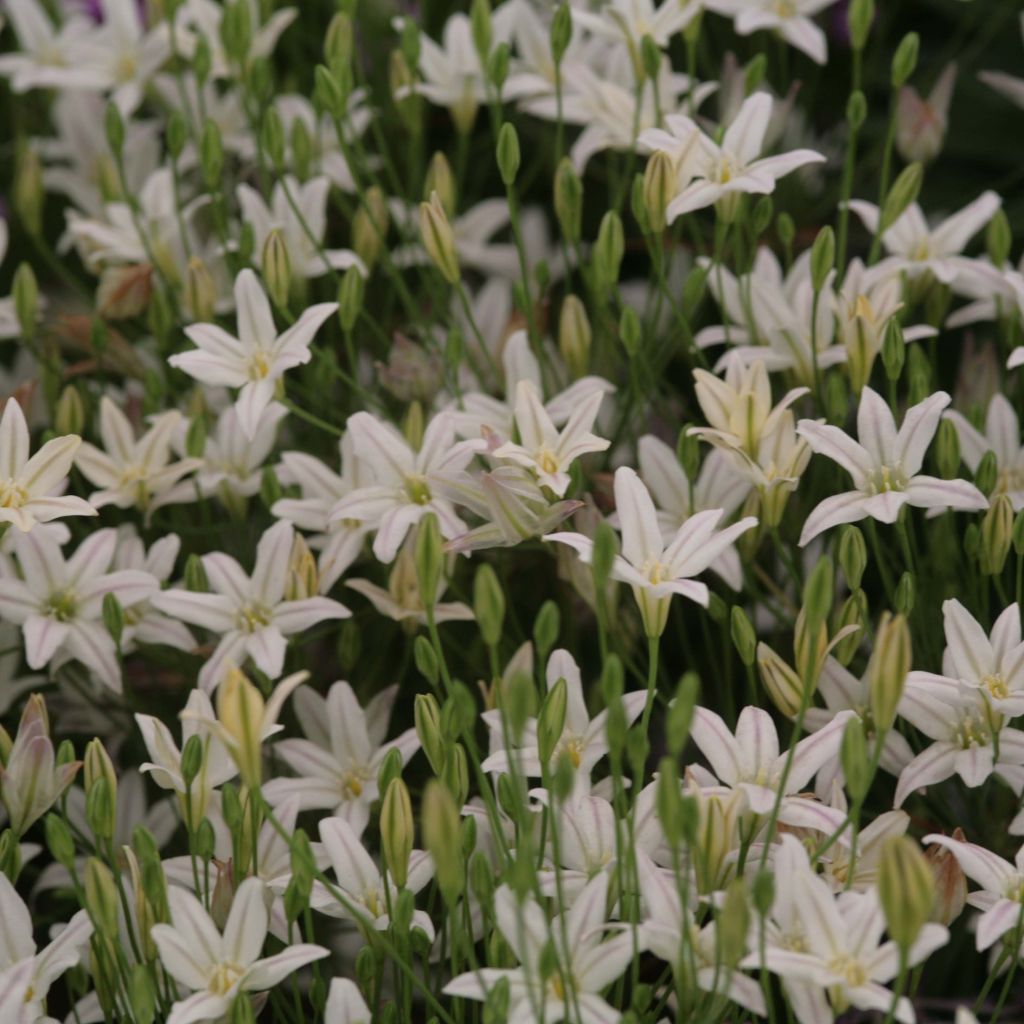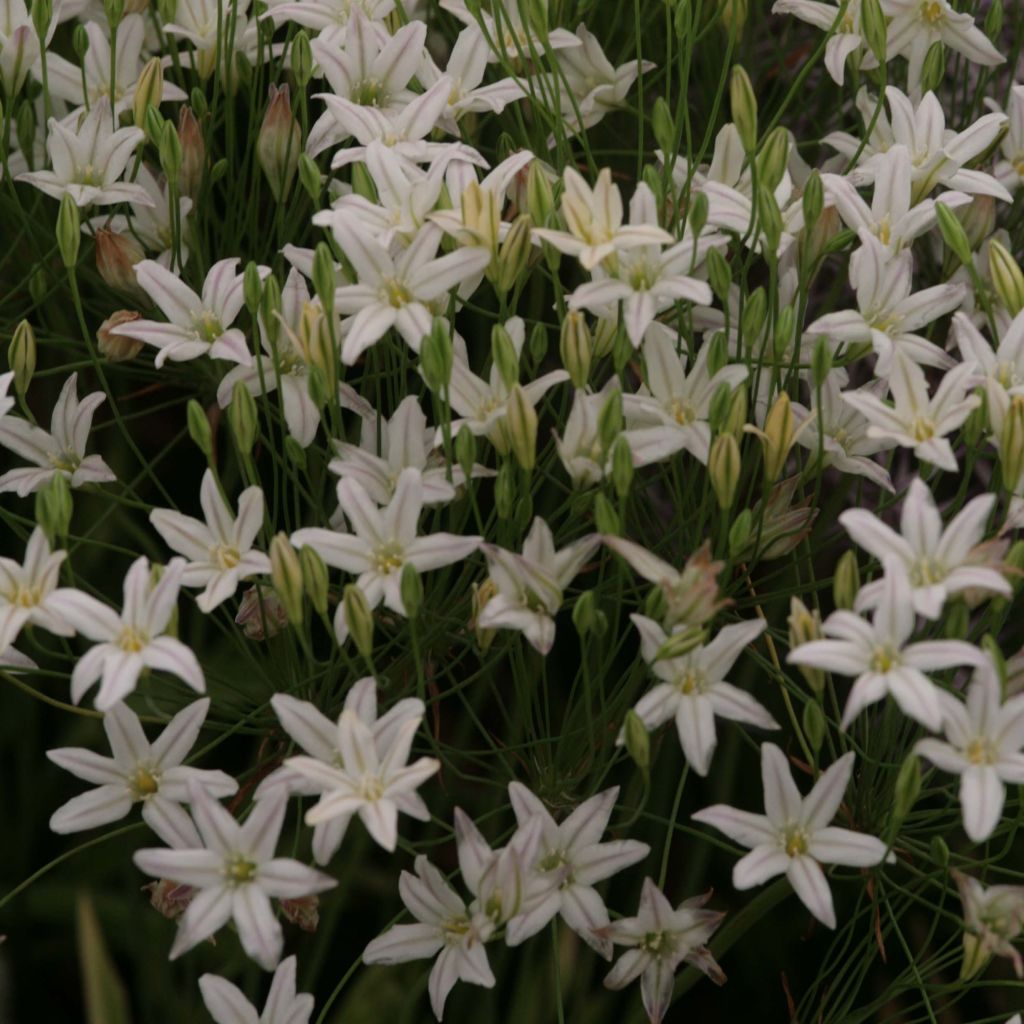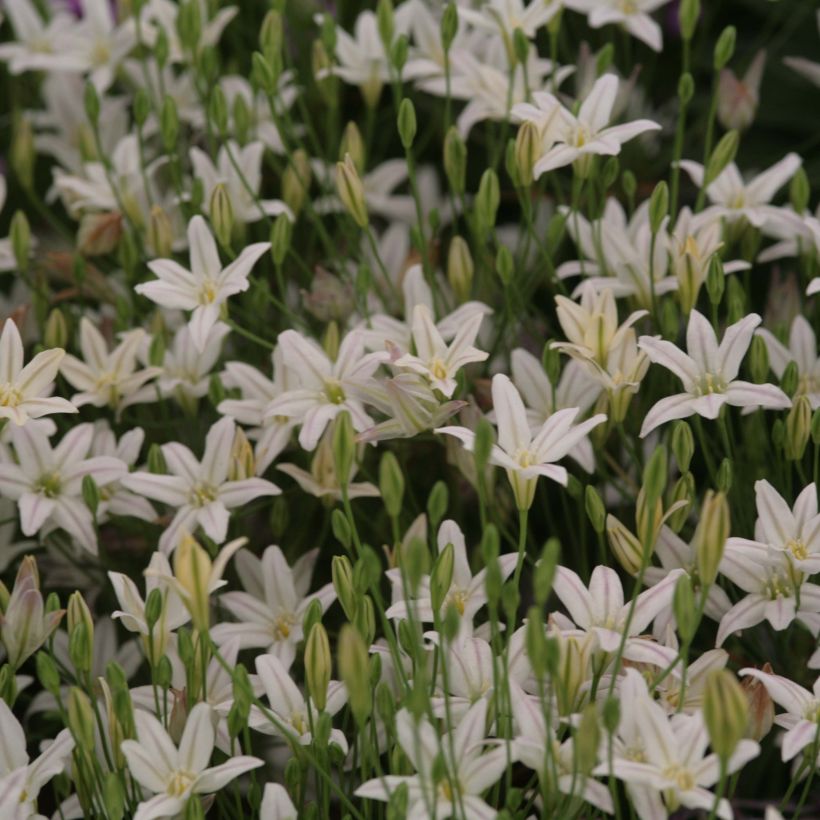

Triteleia laxa Silver Queen


Triteleia laxa Silver Queen
Triteleia laxa Silver Queen
Triteleia laxa Silver Queen
Ithuriel's spear, Grassnut, Wally basket, Pretty face
This item cannot be shipped to the selected country
Delivery charge from €5.90
More information
Schedule delivery date,
and select date in basket
This plant carries a 6 months recovery warranty
More information
We guarantee the quality of our plants for a full growing cycle, and will replace at our expense any plant that fails to recover under normal climatic and planting conditions.
From €5.90 for pickup delivery and €6.90 for home delivery
Express home delivery from €8.90.
Does this plant fit my garden?
Set up your Plantfit profile →
Description
Triteleia laxa 'Silver Queen' is part of a group of bulbous plants related to ornamental garlic, commonly known as Brodiaea, producing umbels of long-lasting star-shaped flowers in bouquets. 'Silver Queen' is a particularly refined and luminous variety, with white and iridescent flowers that have a lovely silver reflection. The plant blooms in late spring or early summer, above a clump of grass-like leaves that disappear more or less early in summer. Give it a place in a very sunny rockery for at least part of the day. Perfectly well-drained soil, even dry in late summer, is the secret to success with this unusual and charming plant.
Triteleia 'Silver Queen' belongs to the Allium family, just like garlic and onion. Triteleia and Brodiaea are bulbous plants native to the West Coast of the United States. Their foliage resembles a tuft of grass. It is not uncommon for it to turn yellow before flowering, which occurs in May or June depending on the climate and region. These bulbs thrive in light and well-drained soil, which should be moist during the growth and flowering period, and then drier until early autumn. They are most commonly planted in autumn, like crocuses and tulips. While they are relatively cold-hardy for the most part (zones 4 to 7 depending on the species), it is advisable to protect them with a thick mulch in winter in colder regions.
The 'Silver Queen' cultivar will reach about 40-50cm (16-20in) in height when in bloom. Vegetation resumes in autumn in mild climates, but in spring everywhere else. The bulb produces a clump of thin, linear, and narrow leaves that are a bright green. The flowering lasts for 3 to 4 weeks in late spring. From the slender, solid, rush-like stems emerge the umbel-shaped inflorescence. Each umbel is composed of about ten small, single, star-shaped flowers, measuring 2 to 2.5cm (1in) in diameter. Each white petal is crossed by a darker grey midline. The plant multiplies by producing bulbils.
Fairly hardy, down to -10/-12°C (14/10.4°F) in well-drained soil, grow Triteleia 'Silver Queen' in the sun (or partial shade in hot regions), in a rockery, or on the edge of a dry garden. It pairs well with catmints, Stipa, and Pennisetums. Thulbagia, small South African plants with corms that are also garlic relatives, with their small pink or violet flowers, as well as variegated Alstroemerias and Ixias, are good companions for Triteleia. Its flower umbels are perfect for bridal bouquets.
Report an error about the product description
Triteleia laxa Silver Queen in pictures


Plant habit
Flowering
Foliage
Botanical data
Triteleia
laxa
Silver Queen
Alliaceae
Ithuriel's spear, Grassnut, Wally basket, Pretty face
Cultivar or hybrid
Planting and care
Hardy down to -12°C (10.4°F) in well-drained soil, not too wet in winter, Triteleia 'Silver Queen' doesn't like too much competition from other plants. Prefer an open, sunny spot (or partial shade in the south) protected from the wind. It likes very well-drained, rocky or sandy soils, moist in spring, drier in summer; don't hesitate to plant it directly in pure sand, its hardiness will be even better. It is indifferent to the soil pH, which can be slightly acidic, neutral or slightly alkaline. If the clumps become too dense after 2 or 3 years, separate the small bulbs produced on the periphery from the main bulbs during the resting period, after flowering.
Planting period
Intended location
Care
This item has not been reviewed yet - be the first to leave a review about it.
Haven't found what you were looking for?
Hardiness is the lowest winter temperature a plant can endure without suffering serious damage or even dying. However, hardiness is affected by location (a sheltered area, such as a patio), protection (winter cover) and soil type (hardiness is improved by well-drained soil).

Photo Sharing Terms & Conditions
In order to encourage gardeners to interact and share their experiences, Promesse de fleurs offers various media enabling content to be uploaded onto its Site - in particular via the ‘Photo sharing’ module.
The User agrees to refrain from:
- Posting any content that is illegal, prejudicial, insulting, racist, inciteful to hatred, revisionist, contrary to public decency, that infringes on privacy or on the privacy rights of third parties, in particular the publicity rights of persons and goods, intellectual property rights, or the right to privacy.
- Submitting content on behalf of a third party;
- Impersonate the identity of a third party and/or publish any personal information about a third party;
In general, the User undertakes to refrain from any unethical behaviour.
All Content (in particular text, comments, files, images, photos, videos, creative works, etc.), which may be subject to property or intellectual property rights, image or other private rights, shall remain the property of the User, subject to the limited rights granted by the terms of the licence granted by Promesse de fleurs as stated below. Users are at liberty to publish or not to publish such Content on the Site, notably via the ‘Photo Sharing’ facility, and accept that this Content shall be made public and freely accessible, notably on the Internet.
Users further acknowledge, undertake to have ,and guarantee that they hold all necessary rights and permissions to publish such material on the Site, in particular with regard to the legislation in force pertaining to any privacy, property, intellectual property, image, or contractual rights, or rights of any other nature. By publishing such Content on the Site, Users acknowledge accepting full liability as publishers of the Content within the meaning of the law, and grant Promesse de fleurs, free of charge, an inclusive, worldwide licence for the said Content for the entire duration of its publication, including all reproduction, representation, up/downloading, displaying, performing, transmission, and storage rights.
Users also grant permission for their name to be linked to the Content and accept that this link may not always be made available.
By engaging in posting material, Users consent to their Content becoming automatically accessible on the Internet, in particular on other sites and/or blogs and/or web pages of the Promesse de fleurs site, including in particular social pages and the Promesse de fleurs catalogue.
Users may secure the removal of entrusted content free of charge by issuing a simple request via our contact form.
The flowering period indicated on our website applies to countries and regions located in USDA zone 8 (France, the United Kingdom, Ireland, the Netherlands, etc.)
It will vary according to where you live:
- In zones 9 to 10 (Italy, Spain, Greece, etc.), flowering will occur about 2 to 4 weeks earlier.
- In zones 6 to 7 (Germany, Poland, Slovenia, and lower mountainous regions), flowering will be delayed by 2 to 3 weeks.
- In zone 5 (Central Europe, Scandinavia), blooming will be delayed by 3 to 5 weeks.
In temperate climates, pruning of spring-flowering shrubs (forsythia, spireas, etc.) should be done just after flowering.
Pruning of summer-flowering shrubs (Indian Lilac, Perovskia, etc.) can be done in winter or spring.
In cold regions as well as with frost-sensitive plants, avoid pruning too early when severe frosts may still occur.
The planting period indicated on our website applies to countries and regions located in USDA zone 8 (France, United Kingdom, Ireland, Netherlands).
It will vary according to where you live:
- In Mediterranean zones (Marseille, Madrid, Milan, etc.), autumn and winter are the best planting periods.
- In continental zones (Strasbourg, Munich, Vienna, etc.), delay planting by 2 to 3 weeks in spring and bring it forward by 2 to 4 weeks in autumn.
- In mountainous regions (the Alps, Pyrenees, Carpathians, etc.), it is best to plant in late spring (May-June) or late summer (August-September).
The harvesting period indicated on our website applies to countries and regions in USDA zone 8 (France, England, Ireland, the Netherlands).
In colder areas (Scandinavia, Poland, Austria...) fruit and vegetable harvests are likely to be delayed by 3-4 weeks.
In warmer areas (Italy, Spain, Greece, etc.), harvesting will probably take place earlier, depending on weather conditions.
The sowing periods indicated on our website apply to countries and regions within USDA Zone 8 (France, UK, Ireland, Netherlands).
In colder areas (Scandinavia, Poland, Austria...), delay any outdoor sowing by 3-4 weeks, or sow under glass.
In warmer climes (Italy, Spain, Greece, etc.), bring outdoor sowing forward by a few weeks.



































